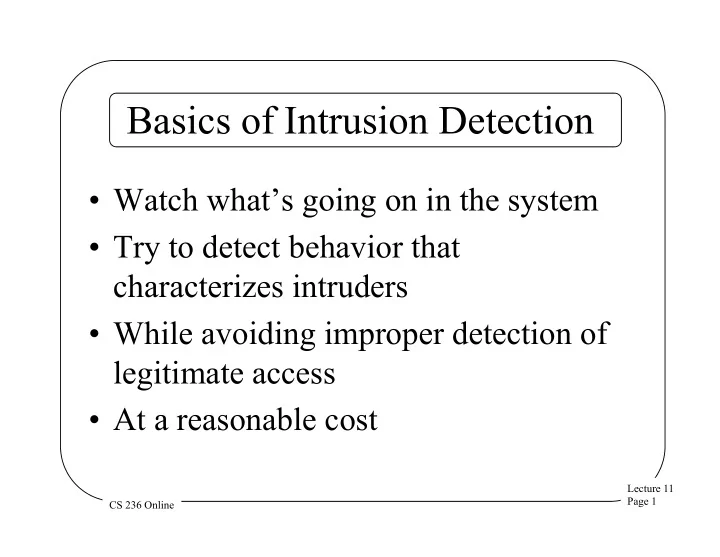

Basics of Intrusion Detection • Watch what’s going on in the system • Try to detect behavior that characterizes intruders • While avoiding improper detection of legitimate access • At a reasonable cost Lecture 11 Page 1 CS 236 Online
Intrusion Detection and Logging • A natural match • The intrusion detection system examines the log – Which is being kept, anyway • Secondary benefits of using the intrusion detection system to reduce the log Lecture 11 Page 2 CS 236 Online
On-Line Vs. Off-Line Intrusion Detection • Intrusion detection mechanisms can be complicated and heavy-weight • Perhaps better to run them off-line – E.g., at nighttime • Disadvantage is that you don’t catch intrusions as they happen Lecture 11 Page 3 CS 236 Online
Failures In Intrusion Detection • False positives – Legitimate activity identified as an intrusion • False negatives – An intrusion not noticed • Subversion errors – Attacks on the intrusion detection system Lecture 11 Page 4 CS 236 Online
Desired Characteristics in Intrusion Detection • Continuously running • Fault tolerant • Subversion resistant • Minimal overhead • Must observe deviations • Easily tailorable • Evolving • Difficult to fool Lecture 11 Page 5 CS 236 Online
Host Intrusion Detection • Run the intrusion detection system on a single computer • Look for problems only on that computer • Often by examining the logs of the computer Lecture 11 Page 6 CS 236 Online
Advantages of the Host Approach • Lots of information to work with • Only need to deal with problems on one machine • Can get information in readily understandable form Lecture 11 Page 7 CS 236 Online
Network Intrusion Detection • Do the same for a local (or wide) area network • Either by using distributed systems techniques • Or (more commonly) by sniffing network traffic Lecture 11 Page 8 CS 236 Online
Advantages of Network Approach • Need not use up any resources on users’ machines • Easier to properly configure for large installations • Can observe things affecting multiple machines Lecture 11 Page 9 CS 236 Online
Network Intrusion Detection and Data Volume • Lots of information passes on the network • If you grab it all, you will produce vast amounts of data • Which will require vast amounts of time to process Lecture 11 Page 10 CS 236 Online
Network Intrusion Detection and Sensors • Use programs called sensors to grab only relevant data • Sensors quickly examine network traffic – Record the relevant stuff – Discard the rest • If you design sensors right, greatly reduces the problem of data volume Lecture 11 Page 11 CS 236 Online
Wireless IDS • Observe behavior of wireless network – Generally 802.11 • Look for problems specific to that environment – E.g., attempts to crack WEP keys • Usually doesn’t understand higher network protocol layers – And attacks on them Lecture 11 Page 12 CS 236 Online
Application-Specific IDS • An IDS system tuned to one application or protocol – E.g., SQL • Can be either host or network • Typically used for machines with specialized functions – Web servers, database servers, etc. • Possibly much lower overheads than general IDS systems Lecture 11 Page 13 CS 236 Online
Recommend
More recommend